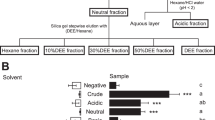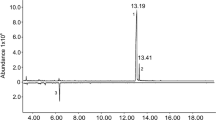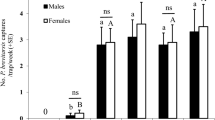Abstract
PHEROMONAL communication by which southern pine engraver beetles signal aggregation and colonisation involves three terpene alcohols, ipsdienol (2-methyl-6-methylene-2,7-octadien-4-ol), ipsenol (2-methyl-6-methylene-7-octen-4-ol) and cis-verbenol first isolated from Ips paraconfusus Lanier in California1. The absolute configurations of these compounds are (1S, 4S, 5S)-cis-verbenol2, (S)-(−)-ipsenol3, and (S)-(+)-ipsdienol4. I. grandicollis (Eichhoff) responds to (S)-(−)-ipsenol5 and seems to produce it as its only pheromonal compound. I. calligraphus (Germar) uses (S)-cis-verbenol and ipsdienol as an aggregation pheromone, and I. avulsus (Eichhoff) aggregates in response to ipsdienol and (S)-(−)-ipsenol, apparently the combination of a pheromone and a kairomone6. Although frass produced by I. paraconfusus attracted I. grandicollis in field tests, it failed to aggregate either I. calligraphus or I. avulsus. Similarly, I. calligraphus producing (S)-cis-verbenol and ipsdienol did not aggregate I. paraconfusus when frass of I. grandicollis was added as a source of (S)-(−)-ipsenol. Laboratory bioassay has confirmed the lack of cross attraction between I. paraconfusus and I. calligraphus7. Furthermore, when synthetic pheromones were used in field bioassay, I. avulsus, I. grandicollis and I. calligraphus readily responded to racemic formulations of their own pheromones, but there has been only one report of field attraction of I. paraconfusus with racemic pheromonal components8. We now offer an explanation for these phenomena which involves the field responses of southern Ips sp. to the enantiomers of ipsdienol9.
This is a preview of subscription content, access via your institution
Access options
Subscribe to this journal
Receive 51 print issues and online access
$199.00 per year
only $3.90 per issue
Buy this article
- Purchase on Springer Link
- Instant access to full article PDF
Prices may be subject to local taxes which are calculated during checkout
Similar content being viewed by others
References
Silverstein, R. M. et al. Science 154, 509–510 (1966).
Mori, K., Mizumachi, N. & Matsui, M. Agr. biol. Chem. 40, 1611–1615 (1976).
Mori, K. Tetrahedron Lett. No. 26, 2187–2190 (1975).
Mori, K. Tetrahedron Lett. No. 19, 1609–1612 (1976).
Vité, J. P. et al. Naturwissenschaften 63, 43 (1976).
Hedden, R. et al. Nature 261, 696–697 (1976).
Lanier, G. N. & Wood, D. L. J. chem. Ecol. 1, 9–23 (1975).
Wood, D. L. et al. Nature 215, 206 (1967).
Ohloff, G. & Giersch, W. Helv. chimica Acta 60, 1496–1500 (1977).
Vité, J. P. & Pitman, G. B. Can. Ent. 101, 113–117 (1969).
Lanier, G. N. Can. Ent. 104, 361–388 (1972).
Vité, J. P. et al. Naturwissenschaften 63, 582–583 (1976).
Tumlinson, J. H. et al. Science 197, 789–792 (1977).
Author information
Authors and Affiliations
Rights and permissions
About this article
Cite this article
VITÉ, J., OHLOFF, G. & BILLINGS, R. Pheromonal chirality and integrity of aggregation response in southern species of the bark beetle Ips sp.. Nature 272, 817–818 (1978). https://doi.org/10.1038/272817a0
Received:
Accepted:
Published:
Issue Date:
DOI: https://doi.org/10.1038/272817a0
This article is cited by
-
10.1007/BF02385082
CrossRef Listing of Deleted DOIs (2011)
-
Enantiomeric composition of ipsdienol: A chemotaxonomic character for north American populations ofIps spp. in thepini subgeneric group (coleoptera: Scolytidae)
Journal of Chemical Ecology (1995)
-
Geometrical and optical isomerism of pheromones in two sympatricDryocoetes species (Coleoptera: Scolytidae), mediates species specificity and response level
Journal of Chemical Ecology (1993)
-
Ipsenol: an aggregation pheromone forIps latidens (Leconte) (Coleoptera: Scolytidae)
Journal of Chemical Ecology (1991)
-
Olfactory-based behavioral interactions among five species in the southern pine bark beetle group
Journal of Chemical Ecology (1990)
Comments
By submitting a comment you agree to abide by our Terms and Community Guidelines. If you find something abusive or that does not comply with our terms or guidelines please flag it as inappropriate.



